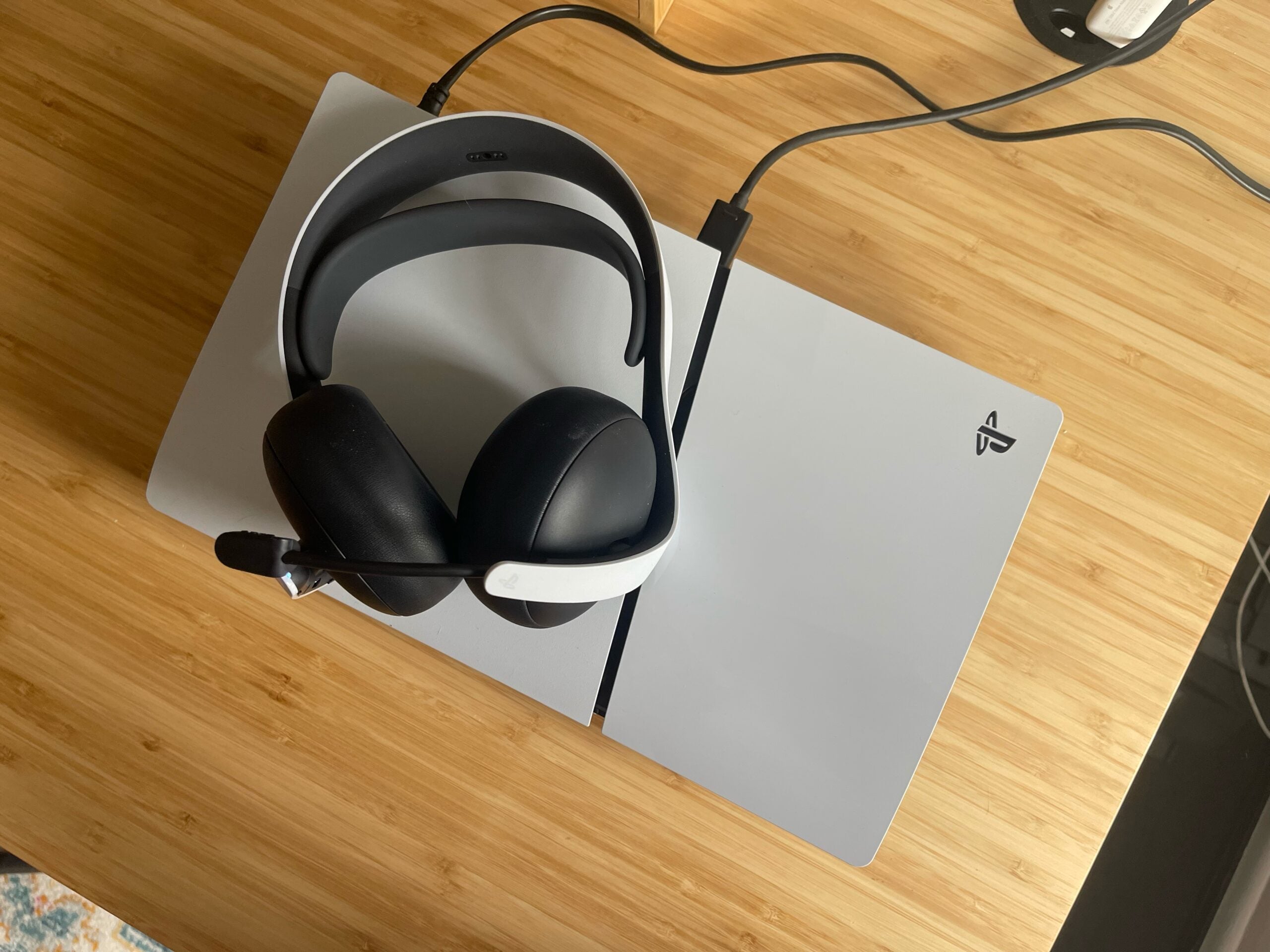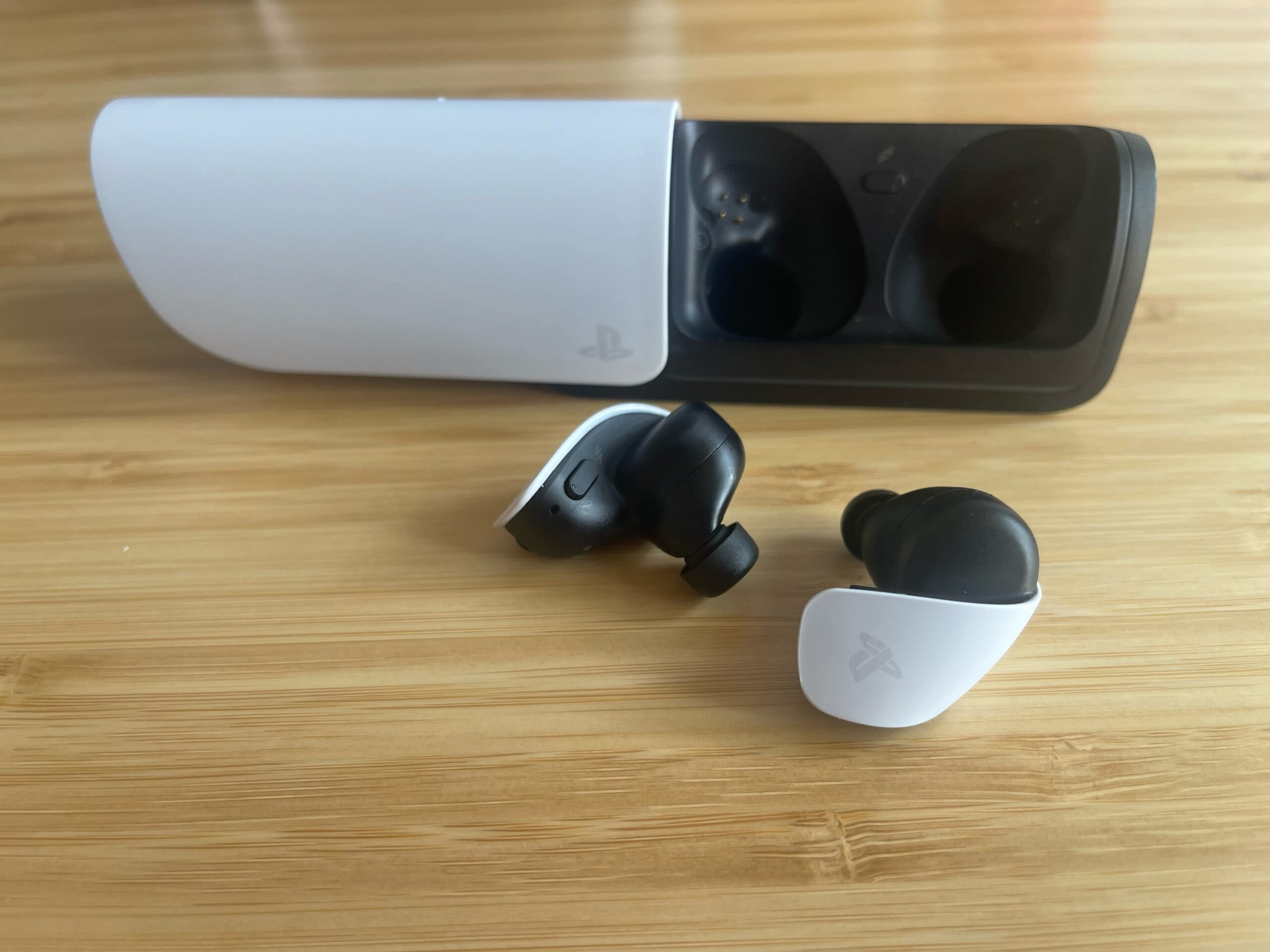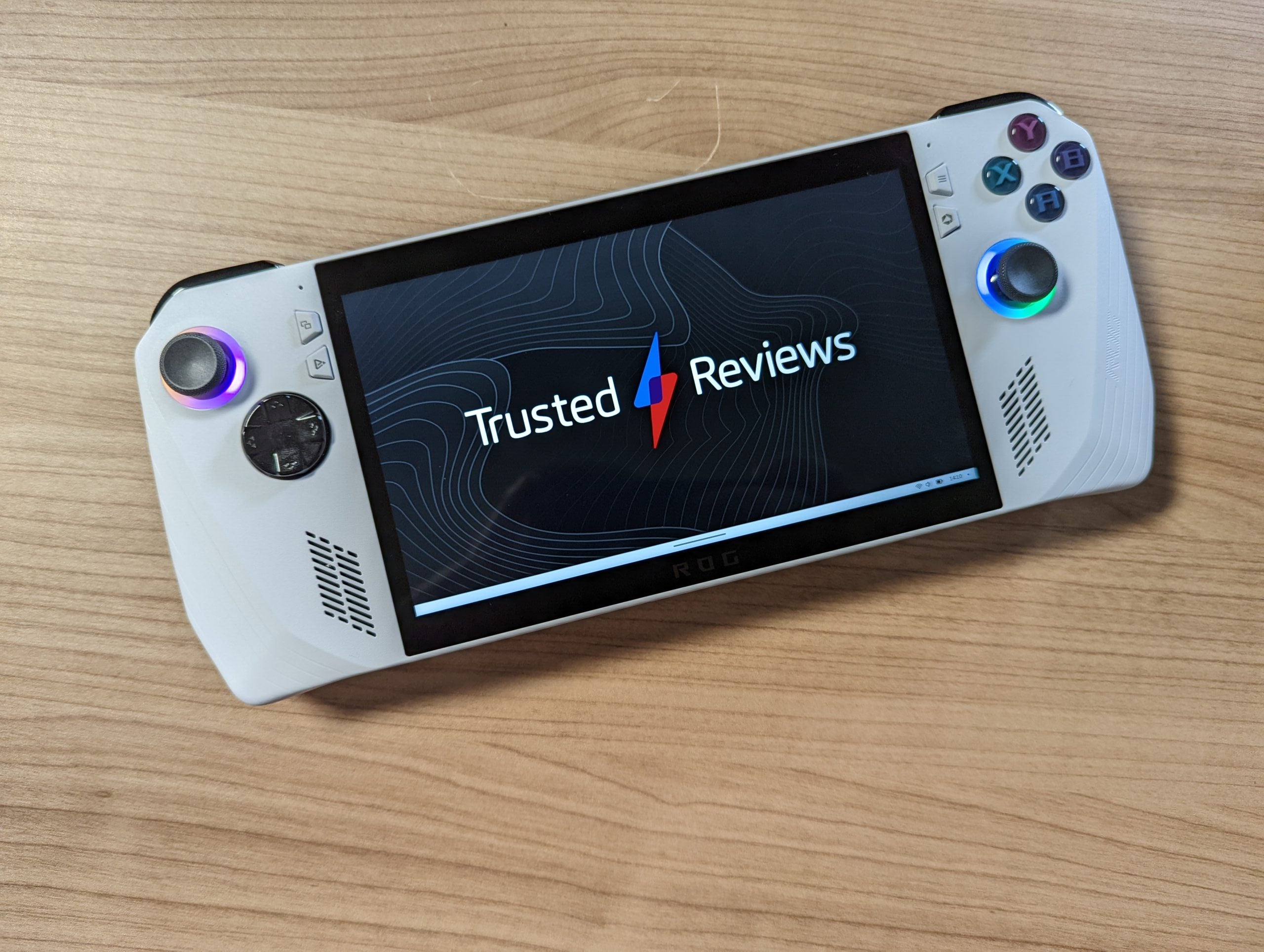Meta Quest 3 Review
The Meta Quest 3 is an easy choice for VR fans, improving the experience in practically every way while introducing colour AR capabilities.

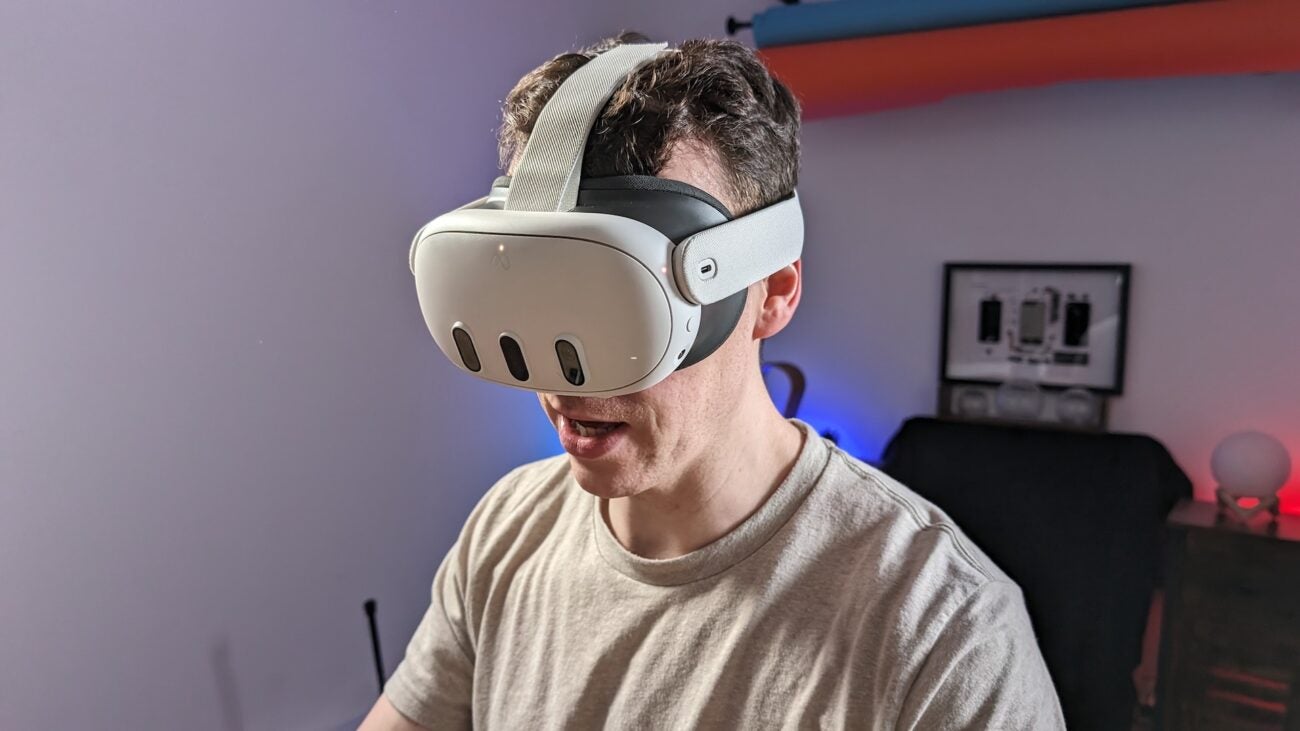







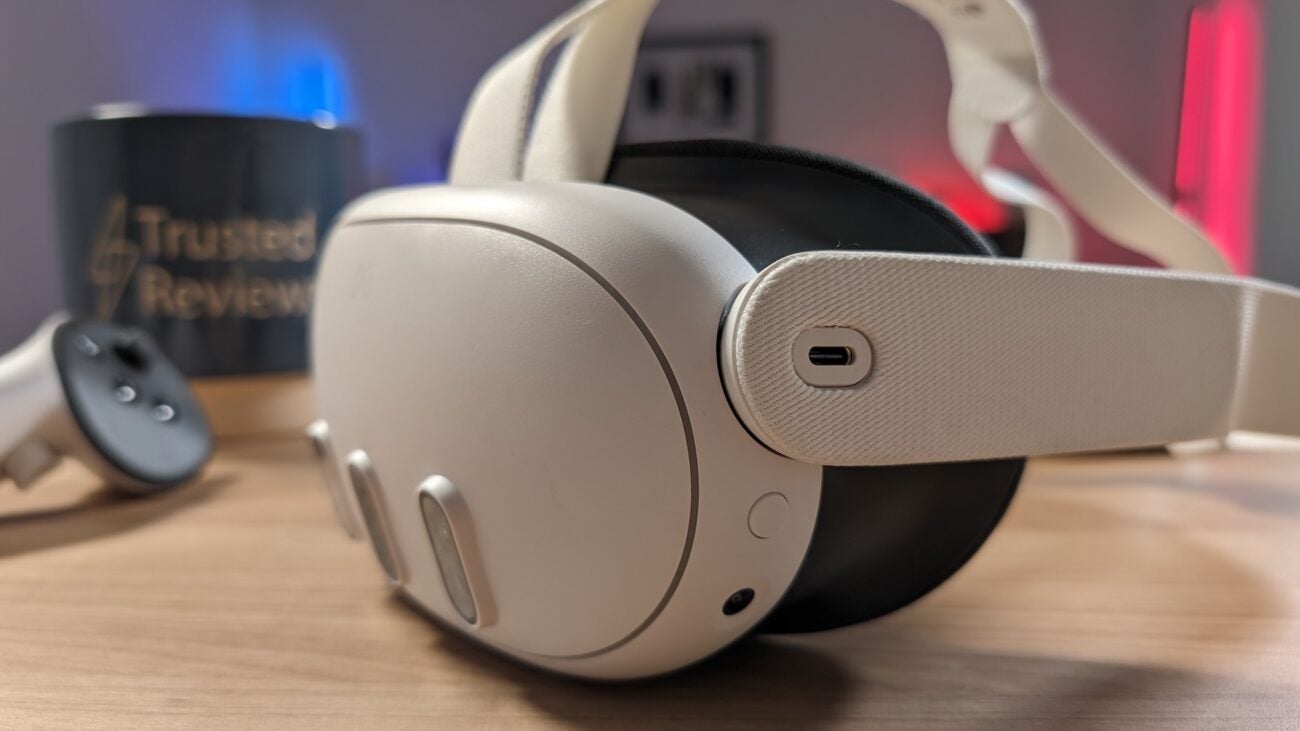


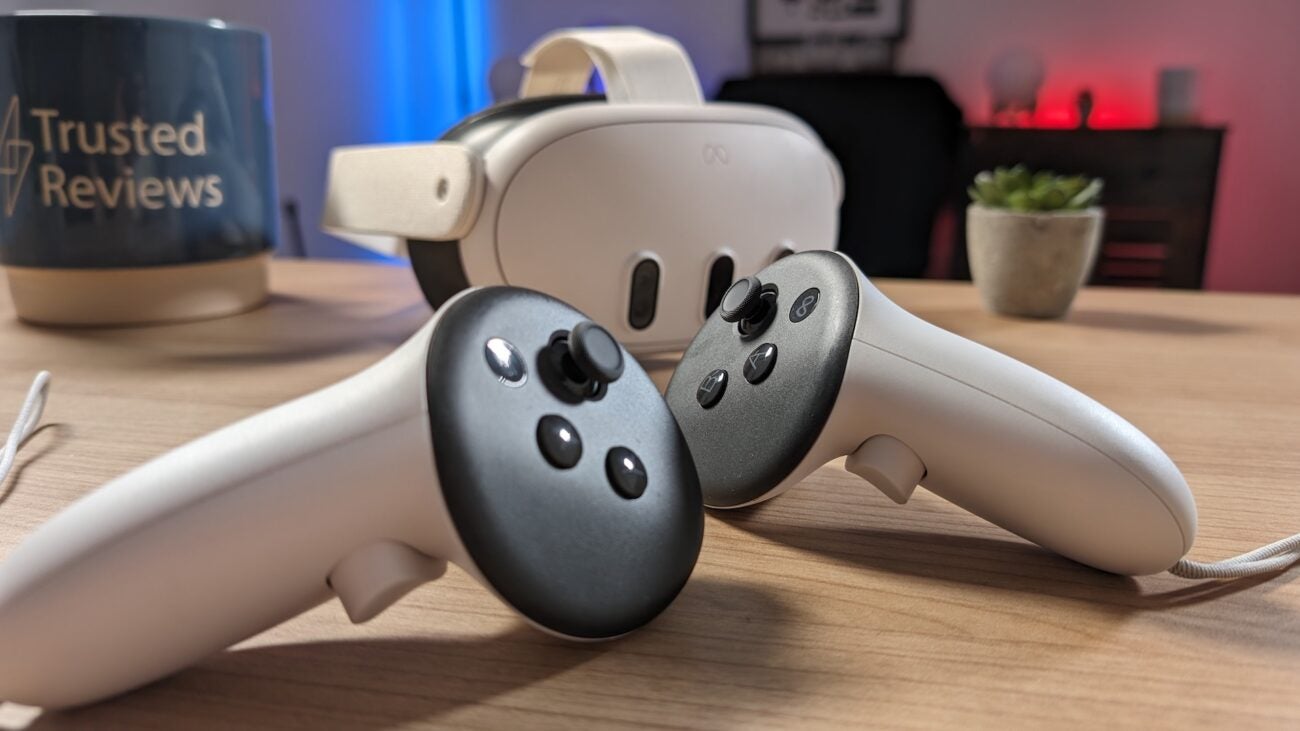


Verdict
The Meta Quest 3 is an easy choice if you’re already a fan of the Quest VR headset, improving the experience in practically every way, from design to optics to performance, while simultaneously introducing fans to the world of AR. However, the increased headset price may make it harder to persuade those yet to try VR to invest.
Pros
- Lightweight, compact design
- Impressive VR and MR experience
- Top-end performance
- Biggest library of apps of any standalone headset
Cons
- More expensive
- Battery life could be better
- Odd warping in passthrough mode
Key Features
- Mixed reality:Blends both the virtual and real-world space to add more variety for apps and game experiences.
- 2x better graphics than Meta Quest 2Snapdragon XR2 Gen 2 chip ensures a signifcantly faster performance with higher-res textures and better lighting effects.
- 4K+ Infinite DisplayProvides close to a 30% resolution boost compared to Meta Quest 2.
Introduction
The Quest 3 is the latest all-in-one VR headset from Meta – and it’s a considerable upgrade over its predecessor in almost every sense.
Sporting a more compact, lighter design with improved optics and higher-res displays, the Snapdragon XR 2 Gen 2-powered VR headset delivers some of the most impressive VR visuals of any standalone headset to date.
The headset also has a renewed focus on augmented reality with tech available that is not even present on the top-end Quest Pro that really makes AR engaging and fun. In fact, much of what Apple is doing with its much-hyped Vision Pro is also available on the Quest 3, including floating AR websites, AR games, and the ability to run apps in AR, all at a fraction of the price.
But while it’s mega cheap compared to the top-end Apple Vision Pro, it’s also much more expensive than its £299 predecessor, starting at an increased £479/$499 with 128GB of storage or £619/$649 if you want to opt for 512GB of storage.
The question is, is the new headset worth the extra cost? Keep reading to find out.
Design and fit
- 40% thinner HMD
- New Y-style strap
- Upgraded pancake lenses
The Meta Quest 3 is an all-round upgrade on the Quest 2, and that begins with its design. Though it looks broadly similar to its predecessor, the Quest 3 head-mounted display (HMD) is significantly thinner – 40% thinner, to be exact.

That significant size reduction is down to the inclusion of an upgraded pancake lens system, which is not only more compact than the frenzel-based system of its predecessor but delivers much clearer optics. Combined with a 30% increase in the resolution of the screens found within, there’s a considerable upgrade to VR and MR visuals, but more on that in a bit.
That all translates to a much more comfortable wearing experience, with a much more balanced weight that doesn’t feel heavy or irritating even after 2+ hour VR sessions, of which I’ve had a few in the past couple of months. The soft cushioning is plush, pleasant to the touch and helps alleviate some of the contact pressure you find on other VR headsets.
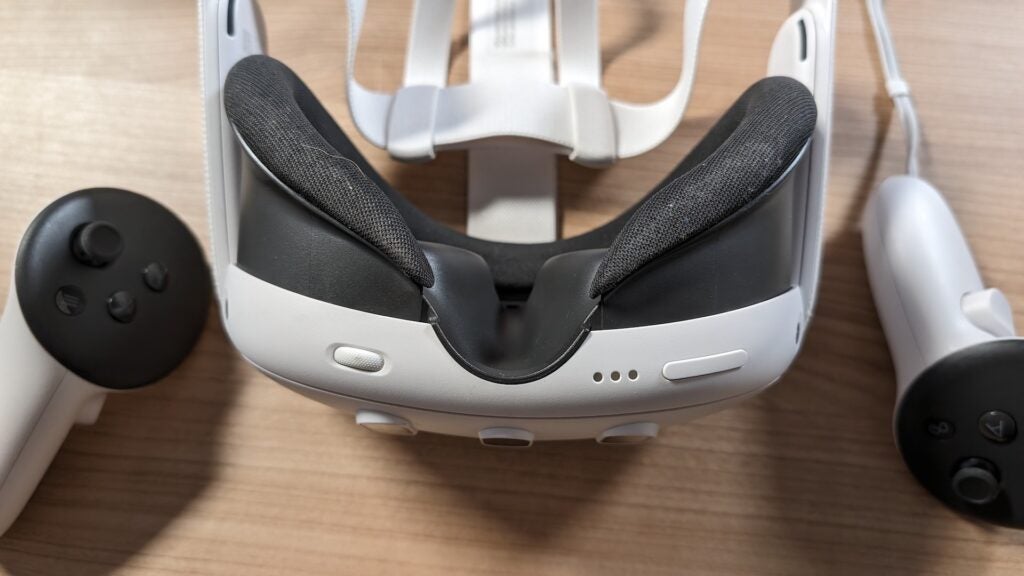
The ability to extend the spacers to accommodate glasses is also a nice new touch, allowing glasses-wearers to enjoy VR and MR experiences without forking out for specially calibrated lenses – though that is still an option if you want.
Once again, the Quest 3 sports open-ear audio with stereo support, though Meta claims it can deliver 40% louder audio than its predecessor.

It’s hard to quantify elements like that, but I can say that the audio is clear and loud enough for me to ignore the pair of wired headphones I tend to use when gaming in VR. The audio is crisp and loud and delivers a decent spatial experience – it just lacks the booming bass that can make music-focused titles like Beat Saber such fun to play.
I wouldn’t say that, overall, it’s better looking than the Quest 2 – the older headset arguably has a cleaner design, lacking the three large central sensor housings of the newer model – but the thinner, lighter HMD and improved optics are certainly a huge win.
The strap has also been redesigned to match, with a new grey Y-style fabric strap bundled in the box with other colourful straps available to buy separately. It takes a bit of getting used to as most of the adjustment is done by moving the two arms of the fabric top strap at the headset to either tighten or loosen it, but once it’s set, you can slip it on and off without any kind of further adjustment.

If that’s not your bag, you can also opt for the Elite strap at an additional cost, which offers the more traditional crank control at the rear of the headset, along with a whole host of first- and third-party accessories to customise your headset. The modular nature of the headset is a boon for accessory makers, and I’m excited to see what becomes available for it in the near future.
Controllers
- Smaller, more ergonomic shape
- No more tracking rings
- Still requires replaceable batteries
Along with a redesigned headset, the Quest 3 controllers have also had a facelift.
The most notable difference is the removal of the large circular tracking ring, allowing for a much smaller, more ergonomic design while retaining access to the same controls as the Quest 2 thanks to a combination of IR LEDs and sensors.

It may not sound like much, but it’s an instantly noticeable improvement on the older controllers that allows you to bring your hands much closer together without the tracking rings clashing, helping overall immersion in VR titles.
Looking at them, you might assume they’re the same as the Quest Pro controllers, but that’s not the case. While both sport a similar look, the Quest Pro controllers are able to track their physical position without being in view of the HMD, while the Quest 3 controllers still need to be in view of the HMD to be correctly tracked.
The Quest 3 controllers also require removable batteries for power, compared to the built-in batteries of the Quest Pro controllers, though with impressive power efficiency, this isn’t as big a deal as it might seem initially.

Specs and features
- Powered by the Snapdragon XR 2 Gen 2 platform
- 128- or 512GB of storage
- New depth sensor removes old pain points
While a lighter, more compact headset and redesigned controllers are great additions to the Quest offering, the real reason to opt for the Meta Quest 3 is the impressive performance on offer.
At the heart of the Quest 3, you’ll find Qualcomm’s brand new Snapdragon XR 2 Gen 2 Platform – the first standalone VR headset to sport the tech – combined with 8GB of RAM.
The new chipset essentially doubles the processing power of the Quest 2, and that elevated experience is further improved by the new pancake lenses. The upgraded optics are much clearer and brighter than the Fresnel lenses of its predecessor, and combined with the upgraded 2064 x 2208 per-eye resolution, it really does feel like a huge step forward for the headset.
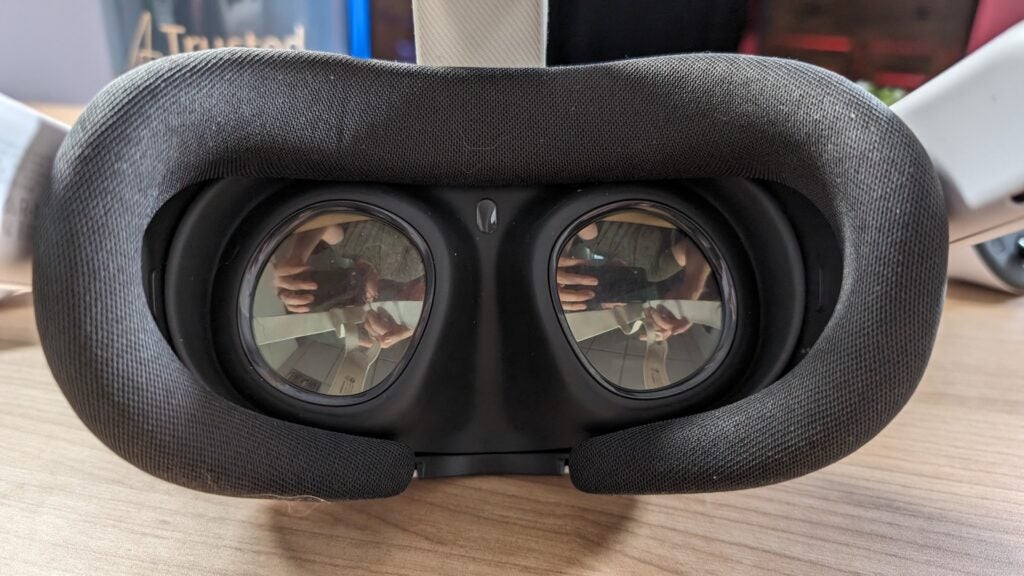
That’s paired with the same 128GB of storage as standard, though you can also opt for the slightly more expensive variant with a much-increased 512GB of storage, doubling that of the high-end Quest 2 and its 256GB capacity.
If you can fork out for the more premium option, it’ll represent a big increase in storage that’ll allow you to be more flexible with your downloads, negating the need to constantly manage storage to fit new, larger games onto the headset without deleting those you play regularly.
There’s also much faster Wi-Fi 6e that, as long as it’s compatible with your home Wi-Fi network, seriously boosts the download speeds of the headsets, and it also vastly improves the wireless PCVR capabilities with higher resolutions, clearer textures and less lag.
However, improved VR is only half the story when it comes to the Quest 3 – the headset also boasts impressive mixed-reality capabilities. That’s largely thanks to the upgraded full-colour cameras on the front of the headset that boast 10x the pixels of the black-and-white Quest 2, and a new depth sensor – not even seen on the top-end MR-focused Quest Pro – really improves things too.

For one, that new depth sensor allows for much easier boundary creation. You can still manually draw your room-scale boundary, but now, you can use the depth sensor to suggest a suitable play area for you. Plus, when it comes to AR games that utilise your real-world environment, the sensor can map out walls, ceilings, sofas and more, and bring those elements into the MR experience.
I also feel like the new depth sensor has had an effect on hand-tracking, a long-time staple of the headset that I’ve always felt was fine, but not perfect. Though it’s still not quite there with the Quest 3, I’ve had much better success in hand-tracked titles like Unplugged: Air Guitar than I did with the Quest 2, and in some dimly-lit environments too.
Games & performance
- Incredible detail in VR games
- Impressive MR capabilities
- Plenty of content on the Quest Store
The improved performance and visuals were best exemplified in Red Matter 2, one of the new titles designed specifically for the Quest 3 that I’ve spent a lot of time in during the review period.
I could instantly tell just how much better the experience was, with levels of detail that could only be described as day and night compared to the Quest 2. The higher resolution of the headset, combined with the pancake optics, meant that text was easily legible, textures were much smoother and more detailed, and everything felt a little more realistic.

The photorealistic approach to Red Matter 2 also means that more minor details, like fingerprints on Polaroid photos and the fine smudges where someone has tried to clean a window, are easily visible.
Dynamic elements like shadows are also notably improved compared to the Quest 2, which didn’t really have the processing power to simulate accurately. That’s especially notable in titles where you use a torch, with the focused light providing much more realistic shadow effects.
Genuinely, I still can’t quite wrap my head around just how much of a difference there is between the two headsets – it’s certainly the one to get if you’re a hardcore VR gamer.

The downside is that unsupported games look especially naff on the headset, with a notable downgrade in terms of resolution and visuals that look closer to what the Quest 2 would deliver. Game devs must manually update their games to take advantage of the new hardware.
But what about mixed reality? It was an interesting concept on the Quest 2, but it couldn’t be fully realised with the headset’s low-res black-and-white passthrough camera setup. Thankfully, the high-res camera setup of the Quest 3 improves things to no end, helping blend the real and virtual worlds into one without such a noticeable difference between the two.
That’s best showcased in First Encounters, a new free-to-play MR title which brings the physical environment into the fun. After mapping, I could shoot away the walls of my real-world space to reveal a larger virtual world behind it – a world where small furry creatures come pouring in.

At that point, the fun truly begins, as you need to shoot as many of the critters in two minutes as possible. What makes it truly remarkable is that the creatures can actually hide behind real-world objects in the room. At one point, I had to physically walk around a chair to get the shot on a particularly sneaky creature.
Of course, that’s just one example of a growing number of ways that devs are implementing MR into their apps. Others, like Little Islanders VR, lets you build a mini-scale world in your living room, while Lego BRICKtales lets you build virtual Lego sets on your tabletop.
You can even access websites in mixed reality, ideal if you want to follow a YouTube recipe when making dinner, and you can easily side-load apps like PS Remote Play to enjoy cloud gaming with a Bluetooth controller. Even though Apple’s high-end alternative, the Vision Pro, boasts a much higher resolution screen and cameras for a more premium AR experience, you’ll find the core of what Vision Pro offers right here – at a fraction of the cost.
The passthrough cameras can also be activated at any time using a double-tap of the headset, allowing you to see and interact with your environment without taking the headset off. I could even reply to texts and check notifications on my smartphone, which certainly couldn’t be said of the Quest 2.
My one complaint is that, like with the Quest Pro, the combined input of several front-facing cameras can cause some odd warping in places. It’s not that noticeable when looking straight-on, but if you move your hand around one of these areas, it’ll look like a reflection of a funhouse mirror.

However, the improved sense of depth in your environment outweighs the odd artefacting issues I’ve seen, and it’s easily ignored once you’re used to it.
Content shouldn’t be a problem either, with the Quest boasting one of, if not the best, selection of standalone VR titles on the market. There are 50+ new MR games headed to the Quest 3, with over 50 being updated to take advantage of the new tech, and there are over 500 VR and MR titles available to download on the platform at the time of writing.
It’s the big advantage Meta has over alternative standalones like the Pico 4 and the HTC Vive Elite XR.
Battery life
- 2-3 hours of battery life
- New Battery Saver mode
- USB-C charging
With battery life taking a hit on the Meta Quest Pro, I was a little worried about what to expect with the Quest 3 – but it turns out that the Quest 3 boasts the same 2-3 hours of battery life as the Quest 2. What’s more, that can be extended by enabling the new Battery Saver mode – though that comes at a hit to overall performance, with a slightly lower refresh rate and downgraded resolution.
However, anecdotally speaking, I did find I’d see the ‘low battery’ warning more often with the Quest 3 than I was used to with the older Quest 2. That might be simply because I’ve been using it more for the purpose of this review, but I’ve hit the low battery warning a fair few times over the past few months that I’ve been using the headset, and that’s after closer to two hours of use than three much of the time.
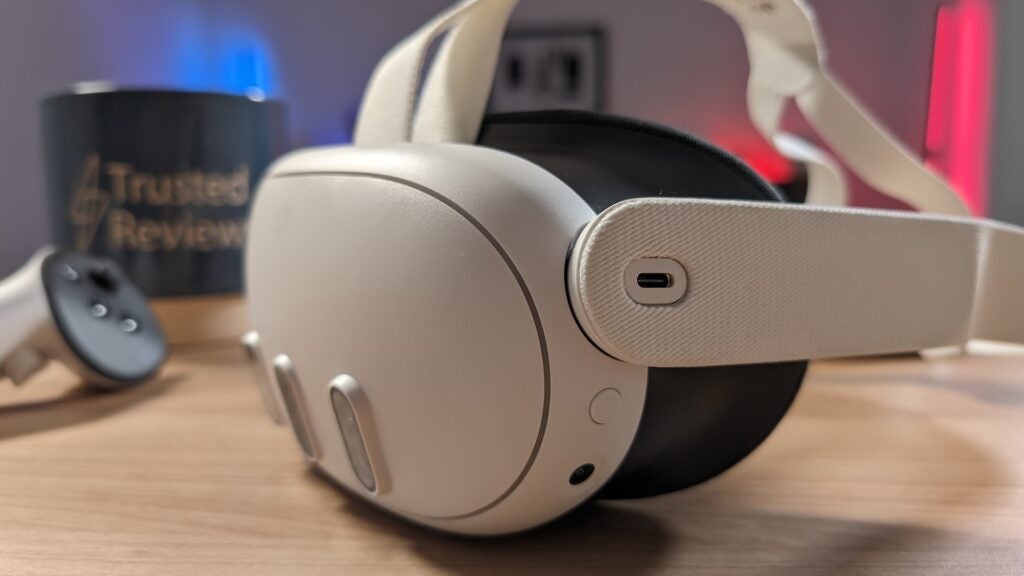
That’ll be fine for more casual VR gamers who just want to play a few games of Beat Saber, but gamers who want to sink their teeth into longer campaigns like that of Red Matter 2 may be left wanting more.
As with its predecessor, you can extend battery life without impacting performance through the use of accessories like the new Elite strap with a built-in battery, but it’s worth noting that you can’t use Quest 2 strap accessories with the Quest 3 due to redesigned audio arms.
Charging is done via a side-mounted USB-C port just like the Quest 2, and a 30W charger in the box will deliver a full charge in around two and a half hours in my experience – and, of course, you can use the headset while it’s charging if you swap the included USB-C cable out for something (a lot) longer.
The controllers, on the other hand, use AAA batteries that’ll need replacing every now and again. However, it’s worth noting that they’re still showing as full even after sporadic use for the past couple of weeks, suggesting pretty good power efficiency from the upgraded controllers.
Latest deals
Should you buy it?
You want an immersive standalone VR/MR experience
The Quest 3 offers impressively immersive VR titles thanks to the upgraded power on offer, delivering an all-round upgrade on what was possible with the Quest 2.
You’ve never tried VR before
The Quest 3 is a capable bit of kit, but it’s also pretty expensive with a £479/$499 price tag. The better option for VR newbies would be the older Quest 2, which, despite being larger and more underpowered, is a much more affordable gateway into standalone VR.
Final Thoughts
If you’re a Quest fan, you’ll love everything about the Quest 3. The design is a big improvement not only in terms of its compact size but how comfortable it is to wear, and the matching compact controllers make for a much more ergonomic experience too.
Of course, it’s the VR experience that’s most impressive, with a truly day-and-night experience compared to its predecessor that manages to not only boost the overall resolution but offer higher-res textures, clearer text, more realistic lighting and more that deliver the most immersive standalone experience to date.
There’s also the new MR angle of the headset, with the aim of blending the real and virtual worlds into one. Combined with new hardware like a depth sensor and high-res colour passthrough cameras, it’s largely a success, and one that, conceptually at least, isn’t that far from what you’d find from the top-end Apple Vision Pro.
However, the higher price compared to the Quest 2 could prove to be a roadblock for consumers yet to try out VR. At £300, the Quest 2 was at the right price for someone to take a gamble and give it a go – I’m not sure that’s the same at the £500 price point of the Quest 3, and especially when the Quest 2 remains on sale as a budget option for £300.
How we test
When testing a VR headset, we make sure to try out a variety of games and apps. We evaluate various aspects, such as the design, fit, screen quality, battery life and the feature set.
Tested a variety of AR and VR titles
Used games and apps to benchmark performance
FAQs
It measures in at 160mm thick.
It uses the Snapdragon XR 2 Gen 2 chipset, the first standalone VR headset on the market to do so.

